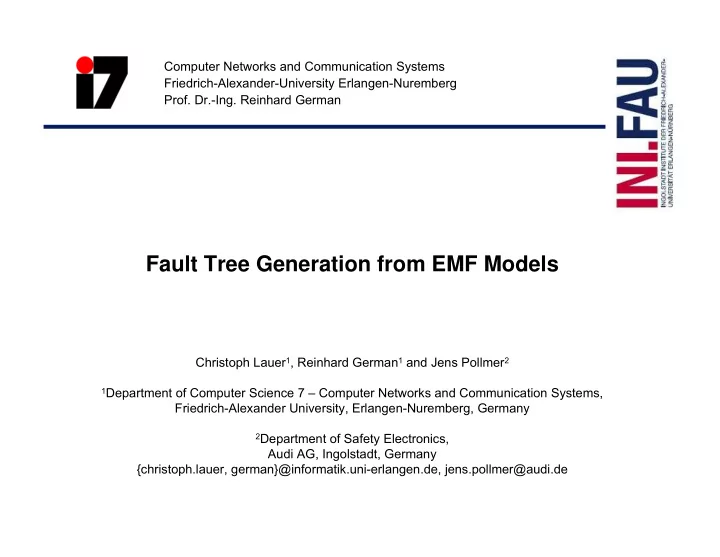

Computer Networks and Communication Systems Friedrich-Alexander-University Erlangen-Nuremberg Prof. Dr.-Ing. Reinhard German Fault Tree Generation from EMF Models Christoph Lauer 1 , Reinhard German 1 and Jens Pollmer 2 1 Department of Computer Science 7 – Computer Networks and Communication Systems, Friedrich-Alexander University, Erlangen-Nuremberg, Germany 2 Department of Safety Electronics, Audi AG, Ingolstadt, Germany {christoph.lauer, german}@informatik.uni-erlangen.de, jens.pollmer@audi.de
Outline � Introduction � Integrated Safety Architectures � System Models � Fault Tree Generation � Conclusions and Future Work 2 Lauer, Christoph, Bounding the Number of Relevant Objects in Automotive Environment 7/6/2009 Perception Systems
(PreVent, 2007) 3 Lauer, Christoph, Bounding the Number of Relevant Objects in Automotive Environment 7/6/2009 Perception Systems
4 Lauer, Christoph, Bounding the Number of Relevant Objects in Automotive Environment 7/6/2009 Perception Systems
Integrated Safety Architecures in the Automotive Domain (1) CAN Integrated ECU Energy Reserve Safety ASIC Controller Watchdog Squibs PSi5 SPI Bus Transceiver x/y φ -x 5 Lauer, Christoph, Bounding the Number of Relevant Objects in Automotive Environment 7/6/2009 Perception Systems
Integrated Safety Architecures in the Automotive Domain (1) Flexray Integrated ECU Energy Reserve Safety ASIC Controller Watchdog Squibs PSi5 SPI Bus Transceiver x/y φ -x 6 Lauer, Christoph, Bounding the Number of Relevant Objects in Automotive Environment 7/6/2009 Perception Systems
Integrated Safety Architecures in the Automotive Domain (3) Flexray Integrated ECU Energy Reserve Safety ASIC Dual Core Controller Watchdog Squibs PSi5 SPI Bus Transceiver x/y φ -x 7 Lauer, Christoph, Bounding the Number of Relevant Objects in Automotive Environment 7/6/2009 Perception Systems
Integrated Safety Architecures in the Automotive Domain (4) Flexray Integrated ECU Energy Reserve Safety ASIC Controller 2 Controller 1 Watchdog Squibs PSi5 SPI Bus Transceiver x/y φ -x 8 Lauer, Christoph, Bounding the Number of Relevant Objects in Automotive Environment 7/6/2009 Perception Systems
Integrated Safety Architecures in the Automotive Domain (5) Flexray Integrated ECU Energy Reserve Safety ASIC Controller 2 Controller 1 Watchdog Squibs PSi5 SPI Bus Transceiver x/y φ -x 9 Lauer, Christoph, Bounding the Number of Relevant Objects in Automotive Environment 7/6/2009 Perception Systems
Task Binding Decisions 10 Lauer, Christoph, Bounding the Number of Relevant Objects in Automotive Environment 7/6/2009 Perception Systems
Requirements for Modeling & Generation � Seperate modeling of system architecture and functional behavior � Flexible allocation of functional tasks to system nodes � Automatic generation of fault trees for further analysis using state-of-the-art tools � No extensive design space exploration 11 Lauer, Christoph, Bounding the Number of Relevant Objects in Automotive Environment 7/6/2009 Perception Systems
EMF Model Support (1) - S_pers - S_trans -T_impl + T_plaus (S_trans) 12 Lauer, Christoph, Bounding the Number of Relevant Objects in Automotive Environment 7/6/2009 Perception Systems
EMF Model Support (2) 13 Lauer, Christoph, Bounding the Number of Relevant Objects in Automotive Environment 7/6/2009 Perception Systems
Transformation Rules 1) Start at top-level event 2) Evaluate top-level event a. Get faults from allocated system entity b. Add faults of entity directly (via OR gate) 3) Evaluate all incoming edges 4) Evaluate node a. Get faults from allocated system entity b. Traverse graph to top-level event c. Add fault directly (via OR gate) if fault propagates, or add guardian (via AND gate) if fault is not propagated 5) Terminate if no incoming edges exist, else go to 3) 14 Lauer, Christoph, Bounding the Number of Relevant Objects in Automotive Environment 7/6/2009 Perception Systems
Transformation Example (1) 15 Lauer, Christoph, Bounding the Number of Relevant Objects in Automotive Environment 7/6/2009 Perception Systems
Transformation Example (2) 16 Lauer, Christoph, Bounding the Number of Relevant Objects in Automotive Environment 7/6/2009 Perception Systems
Transformation Example (3) S_Pers_1 S_Trans_1 S_Pers_i S_Trans_i T_Impl T_Plaus: (S_Trans_1,2,3,i) S_Pers_3 S_Trans_3 S_Pers_2 S_Trans_2 17 Lauer, Christoph, Bounding the Number of Relevant Objects in Automotive Environment 7/6/2009 Perception Systems
Transformation Example (4) 18 Lauer, Christoph, Bounding the Number of Relevant Objects in Automotive Environment 7/6/2009 Perception Systems
Conclusions � Modeling of system and behavior using the EMF � Model transformation from separated system model + behavior model to fault trees � Just a transformation, the algorithm does not „create knowledge“ � Level-of-detail of the fault trees depends on the level-of-detail of the input models � Method supports analysis of different architecture options at early design stages 19 Lauer, Christoph, Bounding the Number of Relevant Objects in Automotive Environment 7/6/2009 Perception Systems
Future Work � Leave the Ecore path for the sake of UML � Modeling of the system and the behavior view using MARTE(+ Depandability profile from Bernardi et al. (2008)) or EAST-ADL2 � Papyrus plug-in for easy modeling without having to cope with UML � Implementation (!) of interfaces to FaultTree+ (ISOGraph) 20 Lauer, Christoph, Bounding the Number of Relevant Objects in Automotive Environment 7/6/2009 Perception Systems
Last slide � Thanks for your attention! 21 Lauer, Christoph, Bounding the Number of Relevant Objects in Automotive Environment 7/6/2009 Perception Systems
Recommend
More recommend